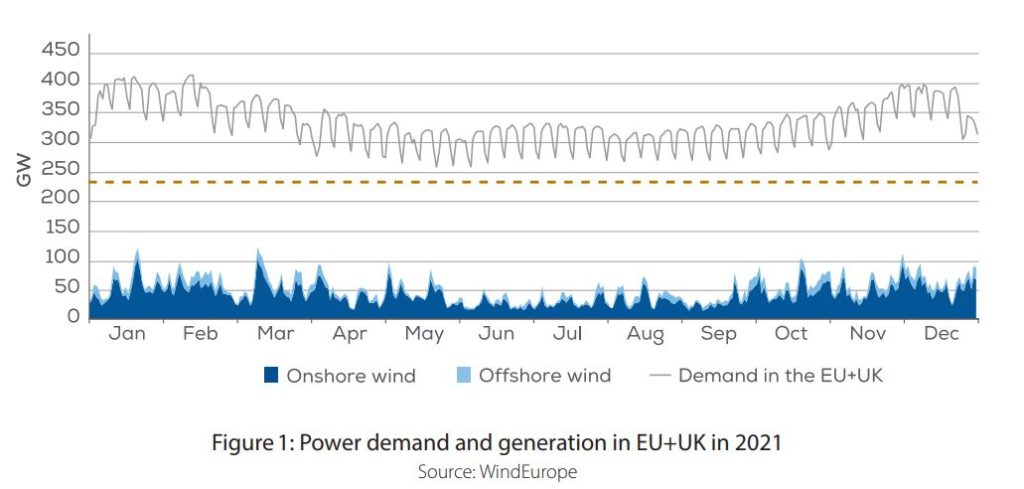Wade Allison has done a short but devastating analysis for the GWPF. The take home message is that the energy contained in the wind is diabolically more erratic than most people realize. It’s just basic physics and almost no one in politics seems able to comprehend just how impossible these numbers are. If only they would “follow the science” eh?
Thanks to Paul Homewood at Notalotofpeopleknowthat.
The exponential death of affordable electricity
It’s just physics. The power of the blowing wind increases by the speed of those particles cubed which produces a twin engineering nightmare. If the wind doubles in speed, the energy goes up by a factor of 8 (or 2 × 2 × 2, and we need to spell it out), and if it slows by half, the energy drops eight-fold. It’s bad both ways. At high speeds, the mechanical engineers have to turn off the turbines to protect them, and at low speeds the electrical engineers have to ramp up power stations that may not exist, or pray to Gaia for batteries that will never exist.
Allison has a graph showing the total output of all the wind turbines in the UK and Europe for a whole year compared to the total electricity needed. As he says “This is not the headline plot that the industry shows to its investors, the media and politicians, but it comes from their own published annual WindEurope Report”.
Just look at this graph from 2021 where wind power is achieving so little in some of the richest nations on Earth and say the words The UN Secretary General wants us all to say: “NetZero by 2040”.
The installed theoretical generating capacity above was 236 gigawatts (shown in the brown dashed line), but the highest daily output in the year was 103 gigawatts which means the other 364 days were worse.
Then consider the entire output of the offshore windfarms of the UK. The wind is more reliable over the ocean, but it’s still an electrical disaster.
In March 2021 there was an eight day period when the wind speed presumably halved and the output plummeted. For eight whole days 8.8GW of wind power was not available (green box). The total energy lost was around 1,600 gigawatt-hours, which is also 1,000 times more than what the biggest battery on Earth could provide.

Figure 2 shows the wind power generated by all UK offshore windfarms in March 2022, as presented online on the Crown Estate website.4 Over some periods, it rose to the nominal installed capacity of 10GW. However, for 8 days at the end of the month it averaged no more than 1.2GW.| Click to Enlarge.
Allison explains the devastating maths of filling in those gaps:
That much energy, 1600GWh, is 1000 times the capacity of the world’s largest grid storage battery (1.6GWh at Moss Landings, California). Batteries 20 million times larger are never going to be available and storage batteries will never make good the failure of offshore wind farms, even for a week. And the wind can drop for longer periods than that.
For those who want the physics, he sums it up so well:
The energy of the wind is that of the moving air, and, as every student knows, such energy is ½Mv2, where M is the mass of air and v the speed. The mass of air reaching each square metre of the area swept by the turbine blade in a second is M=ρv, where ρ is the density of air: about 1.2kg per cubic metre. So, the maximum power that the turbine can deliver is ½ρv3 watts per square metre.
If the wind speed is 10 metres per second (about 20 mph) the power is 600 watts per square metre at 100% efficiency.2 That means to deliver the same power as Hinkley Point C (3200 million watts) by wind would require 5.5 million square metres of turbine swept area – that should be quite unacceptable to those who care about birds and to other environmentalists.
But the performance of wind is much worse than that, as a look at the simple formula shows. Because the power carried by the wind depends on the third power of the wind speed, if the wind drops to half speed, the power available drops by a factor of 8. Almost worse, if the wind speed doubles, the power delivered goes up 8 times, and as a result the turbine has to be turned off for its own protection. This is not related to the technology of the turbine, which can harvest no more than the power that reaches the area swept by its blades.
REFERENCES
Wade Allison (2023) The Inadequacy of Wind Power, Global Warming Policy Foundation.
3 WindEurope Statistics.
4 Crown Estate publishes the running output over the previous 30 days.

